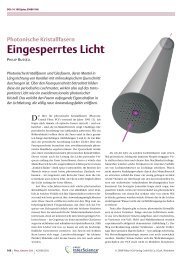Diploma thesis
Diploma thesis
Diploma thesis
Create successful ePaper yourself
Turn your PDF publications into a flip-book with our unique Google optimized e-Paper software.
Material: KTP<br />
Polarizations: y → y + z<br />
775 nm → 1550 nm + 1550 nm<br />
Λ: 68.40 µm<br />
m: -1<br />
Pump FWHM: 0.88 nm<br />
Dimensions: 4 µm x 4 µm x 5 mm<br />
Table 3.4: Proposed and investigated crystal parameters<br />
Figure 3.38: Pump envelope x phasematching function = JSA of the<br />
propsed PDC state<br />
with the additional side peaks of the sinc in figure 3.39. These peaks lead to an<br />
increased distinguishability and limit the minimal achievable amount of entanglement.<br />
The minimum cooperativity parameter possible with this proposed setup is<br />
K=1.20 (S=0.67). It is important to note that a precise control over the pump<br />
width is crucial because already detunings of about 0.5 nm result in a considerable<br />
increase of the frequency correlations (see Figure 3.40). Effects from spatial modes<br />
pose no problem. The phasematching curves, for different spatial modes, are too<br />
much apart as plotted in Figure 3.41, and could be filtered with ease. Additionally<br />
it is unlikely for wavelengths around 1550 nm to propagate in higher spatial modes<br />
in a waveguide of 4 µm x 4 µm. In the experiment we observed only single mode<br />
propagations in this wavelength regime.<br />
Compared with the already implemented group velocity matching in KDP [10, 11],<br />
this proposal exhibits two main advantages. The use of waveguides will result in<br />
a much brighter single photon source and the wavelength of 1550 nm is optimal to<br />
distribute the heralded photons through optical fibers.<br />
30



